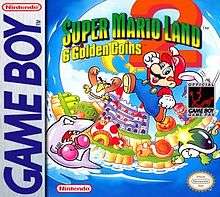Super Mario Land 2: 6 Golden Coins
| Super Mario Land 2: 6 Golden Coins | |
|---|---|
 North American box art | |
| Developer(s) | Nintendo R&D1 |
| Publisher(s) | Nintendo |
| Director(s) |
Hiroji Kiyotake Takehiko Hosokawa |
| Producer(s) | Gunpei Yokoi |
| Composer(s) | Kazumi Totaka |
| Series | Super Mario, Super Mario Land |
| Platform(s) | Game Boy, 3DS Virtual Console |
| Release |
Game Boy 3DS Virtual Console[1]
|
| Genre(s) | Platforming |
| Mode(s) | Single-player |
Super Mario Land 2: 6 Golden Coins[lower-alpha 1] is a platforming video game developed and published by Nintendo for the Game Boy, and is the sequel to Super Mario Land, also on the Game Boy. It was released in Japan on October 21, 1992, in North America on November 2, 1992, and in Europe on January 28, 1993.[2] Super Mario Land 2 was created by director Hiroji Kiyotake rather than Mario series creator Shigeru Miyamoto.
In Super Mario Land 2, the player assumes the role of the protagonist Mario, whose main objective is to reclaim his personal island, Mario Land, from the clutches of his greedy doppelganger Wario. However, Wario is hiding in Mario's former castle and the magical seal that Wario placed on the castle entrance can only be undone by collecting six Golden Coins, which are guarded by Wario's henchmen in various locales of Mario Land. Mario's quest revolves around retrieving each of the golden coins in order to regain access to his castle and defeat Wario. Super Mario Land 2 is notable for the debut of Wario, who would go on to become a major character in the Super Mario Bros. series and even receive two spin-off series of his own.
Gameplay

The objective of Super Mario Land 2 is to reach the end of each level, defeating or avoiding enemies while doing so. The game retains several enemies from the Mario series, such as the Goomba and the Koopa Troopa, and also introduces several new enemies. Enemies can usually be defeated by jumping on their head, but also may need to be defeated in different ways, such as a fireball. Other famous mechanics include Warp Pipes, which allow the player to enter hidden areas or find shortcuts, coins, and ? Blocks, which hide coins and items. Unlike in previous Mario games, coins are not used to get lives; instead, they are used to play games in a special area that awards lives and other power-ups. To gain lives, instead, the player must find hearts like they did in the original. After killing 100 enemies, a star comes flying down which provides a short period of invincibility. The star can also be found at other places in the game. While being invincible, the 5th and each subsequent enemy killed will provide one life.
While its predecessor was similar to the original Super Mario Bros., Super Mario Land 2 has more in common with Super Mario Bros. 3 and Super Mario World: there is an overworld map, the player is no longer restricted to moving only right in a stage, many stages contain higher and lower areas instead of entire stages all at a single level, and any stage (except for the introductory stage and "boss" levels) can be replayed multiple times. At the end of a level, there is a door that must be touched to clear a level. In addition, there is also a bell high above the door which, if touched, activates a mini-game where the player can try to get either a power-up or 1-ups. The six worlds can be played in any order unlike in most Mario games that feature overworld maps. The game saves the player's progress after beating a stage, being the first Mario game released on a portable system to have a save feature.
There are 32 levels in total, based in several different themed zones. There are some secret levels that can only be accessed by finding alternative exits found in regular levels. Once a player clears or loses a life in these secret levels, they are returned to the level where the secret exit was found. Each zone has its own boss, which must be defeated to get one of the 6 Coins. If the player loses all of Mario's lives, all of the 6 Coins are returned to the bosses, which must be defeated again to retrieve the coins. From the beginning of the game, the player may choose to complete the zones in any order.
Super Mario Land 2 features three returning power-ups—the Super Mushroom, Fire Flower, and Starman. The Super Mushroom increases Mario's size, the Fire Flower gives him the ability to shoot fireballs, and the Starman makes Mario invincible for a short time to anything besides pits. Both the Super Mushroom and the Fire Flower also allow Mario to do a spin jump like in Super Mario World. Due to the grayscale palette, Fire Mario is differentiated from Super Mario by having a feather in his cap, a feature not seen in any other Mario series game. Also unique to Super Mario Land 2 is the Magic Carrot power-up, which turns Mario into Bunny Mario. Bunny Mario can jump higher, jump repeatedly by holding down the jump button, and descend slowly using his ears.
Like its predecessor, this game also incorporates unique sound effects that are mostly different from the main Mario platformers. The most noticeable are the Starman sound and the 1-Up fanfare.
Upon collecting all Golden Coins, Mario's Palace is unlocked, where the player must fight Wario in a castle room. To defeat Wario, the player must jump on Wario's head three times, a process that must subsequently be repeated in two additional rooms.
Plot
Super Mario Land 2 takes place immediately following the events of Super Mario Land. While Mario was away in Sarasaland, his old childhood friend Wario put an evil spell over Mario's private island, Mario Land, brainwashing its inhabitants into believing Wario is their master and Mario is their enemy. Wario's motive behind this sudden attack is to steal Mario's castle out of a desire to have a palace of his own. After traveling through Mario Land and collecting the six Golden Coins, Mario regains entry to his castle. Mario enters and defeats Wario, who flees, breaking his spell and causing Mario's castle to revert to its normal form.
Development
The music was composed by Kazumi Totaka, and it is one of his earliest works. "Totaka's Song" is also hidden in the game and can be heard in the Game Over screen after waiting for 2 minutes and 30 seconds.[3]
Legacy
The January 1993 issue of Nintendo Power magazine contained a 10-page comic entitled Mario vs. Wario which was a loose retelling of Super Mario Land 2's plot. In the comic, Mario's childhood playmate Wario invites him over to his castle to "catch up on things". Unbeknownst to Mario, however, Wario is secretly plotting revenge on Mario who he believes used to bully him when they were children. During his trip to Wario's castle, Mario encounters several of the bosses from the game who were sent by Wario to eliminate Mario, a detail of which Mario is unaware. Upon reaching Wario's castle, Mario encounters a giant Wario whom Mario defeats by pulling a plug on his overalls. The comic ends with Mario apologizing to Wario and playing cowboys with Wario once again vowing revenge on Mario. In August 2016, it was reported that Mario vs. Wario and it's predecessor Super Mario Adventures would be re-released by VIZ Communications.[4]
Super Mario Land 2 DX: 6 Golden Coins
On December 25, 2017, a rom hack of Super Mario Land 2: 6 Golden coins was released entitled Super Mario Land 2 DX: 6 Golden Coins, which removed screen flickering issues present in the original game as well as adding color and the ability to play as Luigi who jumps higher than Mario.[5]
Reception
| Reception | ||||||||||||||||
|---|---|---|---|---|---|---|---|---|---|---|---|---|---|---|---|---|
| ||||||||||||||||
Official Nintendo Magazine ranked Super Mario Land 2 44th on their list of the "100 Greatest Nintendo Games".[8] Nintendo Power listed it as the seventh best Game Boy/Game Boy Color video game, praising it for its improvements over Super Mario Land and for having impressive visuals for a handheld game.[9] Allgame also commented on the graphics, stating that the similar platform game Donkey Kong Land displays "more detailed graphics, the downside to this is that levels tend to blur quite a bit more when in motion. So in this respect, you get a fair trade off."[7] The review concluded that "In overall fun and enjoyment, it's hard to go wrong with this title. It's not a very long game, but even experienced players should find a little challenge in it. It's excellent for road-trips where you may only play in short sessions."[7]
Game Informer's Ben Reeves called it the fourth best Game Boy game and praised its levels' creativity.[10] Before it became available, GamesRadar listed Super Mario Land 2 as one of the titles they want in the 3DS Virtual Console.[11] The UK-based magazine Total gave the first Super Mario Land game 94%, but only gave the sequel 70%.[12][13]
Re-release
The game was released for the Nintendo 3DS's Virtual Console service eShop on September 29, 2011, in North America and Europe, and was released on October 12, 2011, in Japan.[1]
Notes
- ↑ Super Mario Land 2: 6 Golden Coins (スーパーマリオランド2 6つの金貨 Sūpā Mario Rando Tsū Muttsu no Kinka)
References
- 1 2 "Super Mario Land 2: 6 Golden Coins". Nintendolife.com. Retrieved 2011-09-25.
- ↑ Super Mario Land 2: 6 Golden Coins Info - Super Mario Land 2: 6 Golden Coins Information - Super Mario 6 Golden Coins Release Date
- ↑ Inside Nintendo 38: Super Mario Land wird 25! (Teil 2) (Nintendo-Online.de, 2014-04-20)
- ↑ Peters, Megan (7 August 2016). "Nintendo Power's Super Mario Adventures Comic Getting New Collection". Comicbook.com. Retrieved 23 September 2018.
- ↑ Machkovech, Sam (25 December 2017). "A Christmas gift from Game Boy ROM hackers: Super Mario Land 2 in color". Ars Technica. Retrieved 23 September 2018.
- 1 2 3 "Game Rankings Super Mario Land 2: 6 Golden Coins Reviews". GameRankings.com. Retrieved 3 November 2012.
- 1 2 3 Kosydar, Aaron. "Super Mario Land 2: 6 Golden Coins - Review". Allgame. Archived from the original on November 14, 2014. Retrieved May 5, 2015.
- ↑ East, Tom (2 March 2009). Feature: 100 Best Nintendo Games. Official Nintendo Magazine. Retrieved on 18 March 2009
- ↑ "Nintendo Power - The 20th Anniversary Issue!" (Magazine). Nintendo Power. 231 (231). San Francisco, California: Future US. August 2008: 72.
- ↑ Reeves, Ben (2011-06-24). "The 25 Best Game Boy Games Of All Time". Game Informer. Retrieved 2013-12-06.
- ↑ "12 classic Game Boy and Game Boy Color games we want on 3DS". GamesRadar. Jan 19, 2010. Retrieved 2011-01-27.
- ↑ https://archive.org/stream/Total_1993_Special_1993_Future_Publishing_GB#page/n39/mode/2up
- ↑ https://archive.org/stream/Total_Issue_014_1993-02_Future_Publishing_GB#page/n9/mode/2up
